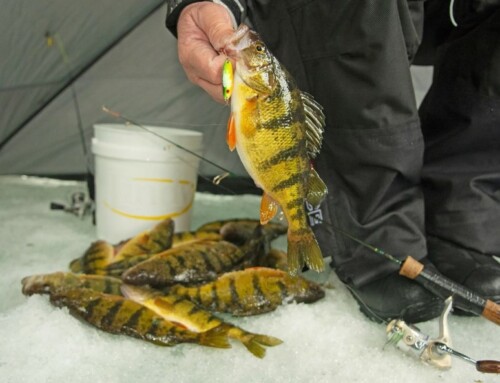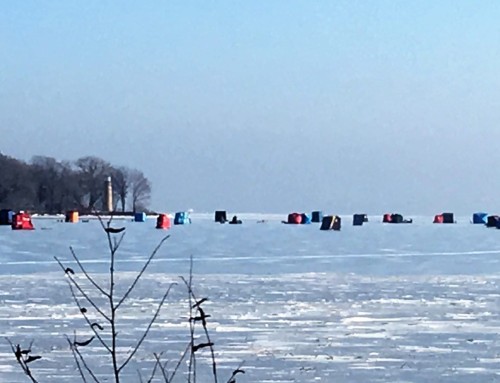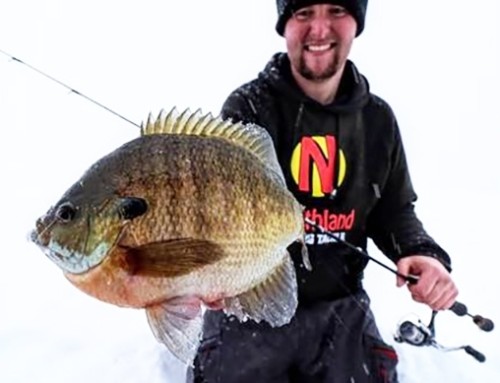Let’s talk about equipment for a minute, after all that is usually what causes the most early season headaches. Go into your garage NOW and take some time to inventory and inspect your gear. Shelters, augers, rods/reels, tackle, accessories.
Portable shelters-If you have a flip over style, set it up to make sure it’s free of rips and tears. Clean out the tub section, check your wear bars underneath, tighten all the fasteners on the hitch assembly and spray some PAM cooking oil on the poles where they pull out.
Hub style or Pop-up shelters-this style house designed and popularized by Eskimo has changed the way many people fish. These too need to be set-up to check the condition before venturing out. Also look at the Ice Anchors and ropes. These small, but important pieces are your lifeline on windy days out on the ice. I personally like to make 4-5 short 5 ft ropes with a small carabineer on each end to aid in securing them to the ice.
Augers- not only should you start and run your auger for a while, but check the blades also. Many times I have heard people complain about how their auger doesn’t drill when they get it on the ice. Usually this is caused by dull blades and it’s a good idea to carry a spare set in your tackle box at all time. If you summerized your Gas or Propane auger at the end of the last season, it should run and drill fine, but you still need to check it. If you have invested in the newest ice auger technology, the ION 40 v lithium ion auger, all you need to do is check the blades.
Electronics-Make sure your flasher batteries are charged and the connections are clean. We plug in our Vexilars a few times during the off season to keep the batteries in top condition. Its all basic stuff, but you would be amazed on how many guys don’t take are of their electronics batteries. If your unsure of its condition and its over a few years old, may want to purchase a back-up before the season starts. Another little tip, make sure your transducer and power cords are not wrapped too tightly or pinched during storage.
Now that we have the big ticket items ready, let’s look at the smaller things. Rods/reels/line- this is very important because your line is the only link between you and the fish. And the rod/reel is the tool that manages that important link. If you use mono, change it each season, but with superlines and tip-up lines, you can usually get by a couple seasons before changing. Always remember to use the lightest line you are comfortable with, you will increase your catch rate by 10% each time your drop one line size.
 This is the time to go through your tackle trays and check the condition of your jigs, hooks, bobbers, ect. If you’re planning on fishing a “Barbless” Canadian province you may want to switch out the trebles on the lures with “Triple grip” trebles and pinch the barbs, this really helps to keep those fish hooked up. Organize by lure style and if you have a LOT of tackle, organize by species. We personally like to use the Striker Ice Rod Transporters for quick easy storage.
This is the time to go through your tackle trays and check the condition of your jigs, hooks, bobbers, ect. If you’re planning on fishing a “Barbless” Canadian province you may want to switch out the trebles on the lures with “Triple grip” trebles and pinch the barbs, this really helps to keep those fish hooked up. Organize by lure style and if you have a LOT of tackle, organize by species. We personally like to use the Striker Ice Rod Transporters for quick easy storage. We keep one with smaller panfish rods and light tackle tor perch, sunfish and crappies. We then have another with longer walleye rods and larger tackle used for the toothy critters. It’s a good system that allows you to just grab the transporter that correlates for the targeted species of the day. We also like to have a small selection of pliers, clippers, fish scents, and other assorted goodies to stuff in our jacket pockets. Get all these things out in a small plastic tub next to your ice gear, that way its ready every time you go. It’s kind of like having your wallet at the same place on the kitchen counter or nightstand. It needs to be somewhere you won’t forget it.
When you’re done organizing the tackle, take a “Phone Pic” of all your gear. This serves a couple different purposes. If your stuff ever gets stolen, you will have a record. It also comes in handy when at the local sporting goods store and you are trying to remember what color of this lure you wanted or what size jig you needed.
Hopefully your outerwear made it through the summer in good condition. Boots, bibs, jackets. Good quality outerwear kept in good condition is a tool that will enhance all your fishing outings. Warmth, comfort, waterproof, padded/reinforced knee’s, multiple pockets. There are even styles like the Striker Ice Climate Suit that that add an element of safety due to its floatation feature. The floatation suits are especially important during the early ice period. Put on the suits, check for rips and tears, and check out all the pockets. This is a good time to get your accessories and figure out where they are going to fit into your jacket “System”. Most of today’s outwear has multiple pockets for everything you may need, and it’s your toolbox. Use it as such
Another advantage to getting everything ready now, is that if you are short something, this is the best time to go shopping. Ice Shows, the winter version of the very popular boat shows in the spring, are all happening in the next 6 weeks throughout the Ice belt. StPaul Ice Show will be Dec 4-6, and the Arrowhead Ice Show in Duluth is Dec 11-13. All of these shows have the latest in ice fishing equipment, along with factory reps to help you decide what works best with your style of fishing.
If you are looking to gain an edge on early season ice fishing, preparation is the key. Be more efficient, stay out longer, catch more fish.
BY WISHLIST ADMIN ·– Brewer-Agre Outdoors






